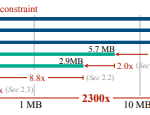2022-12-26 アメリカ合衆国・マサチューセッツ工科大学(MIT)

・ MIT が、ナノ粒子の配列と位置を精確に制御して材料表面の損傷等の無いナノ構造をボトムアップ作製する、ナノ粒子コンタクトプリンティング技術を開発。
・ トランジスタ等のナノスケールデバイスは、材料のエッチング処理でナノ構造を形成するトップダウ
ンの方法で製造されているが、最高性能と新機能が獲得できる超微細なナノ構造の作製には高価な機器を要し、高度な精密度での達成が難しい。
・ 例えば、ナノ粒子を「成長」させた化学物質の溶液をテンプレートに配置し、別材料の表面に転写する方法があるが、これには数千個ものナノ粒子をテンプレート上で効率的に処理する必要がある。また、転写の際に化学接着剤や高圧力・高温度を要するため、転写先のデバイスの表面を損傷・汚染し、性能を損失させる可能性がある。
・ ナノ構造をボトムアップ作製する新技術では、これらの制約を克服。まず、特定のサイズと形状のナノ粒子を溶液中で作製し、次にナノ粒子の配置を決定するナノサイズのガイド(トラップ)で覆ったフレキシブルなテンプレートを作製する。
・ 僅か 50nm の無数のナノ粒子を含んだ溶液をテンプレートに流し込むと、毛管引力がナノ粒子を適正な位置に移動させ、ファン・デル・ワールス力(分子間引力)がそれらを保持し、転写可能なナノ構造が完成する。
・ それぞれの引力が協働できるよう、テンプレートガイドを適切なサイズ、形状、配置に設計することで、ナノ構造に不利となるそれらの引力を高精度に制御する。溶液や表面処理、高温度等を使わずにこれらのナノ粒子を様々な表面に転写できるため、クリーンな表面を保持し、95%超の転写収率が達成できる。
・ アルファベット文字等の形状にナノ粒子を配置し、高い位置精度でのシリコンへの転写を実証。様々な形状と材料のナノ粒子を、金をはじめ次世代電子・光デバイスのフレキシブルな基板等の様々な表面に効果的に転写できる。
・ 新技術はスケーラブルで、実用デバイス製造への利用に拡大が可能。新しいタイプの電子・光デバイスの開発に向け、より複雑なナノ構造の作製とその転写での新技術の活用を試みている。
・ 本研究は、米国立科学財団(NSF)と NSF Graduate Research Fellowship Program が支援した。
URL: https://news.mit.edu/2022/nanoparticles-printing-silicon-1026
<NEDO海外技術情報より>
関連情報
Science Advances 掲載論文(フルテキスト)
Nanoparticle contact printing with interfacial engineering for deterministic integration into functional
structures
URL: https://www.science.org/doi/10.1126/sciadv.abq4869



